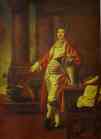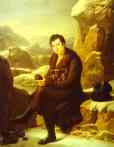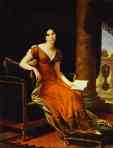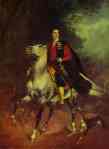This page was prepared with the help of Alexandre Tissot-Demidoff
The Demidovs (also Demidoffs)
The Demidovs were a dynasty of great Russian industrialists in the 18th
and 19th centuries.
The founder of the dynasty, Nikita Demidov (1656-1725), son
of Demid Antufiev (Antoufiev), a free blacksmith from Tula, was an associate
of Peter I the Great. Peter I liked the guns made by Nikita Demidov very
much (they were cheaper than foreign ones and of the same quality), and
made Nikita the main gun provider of the Russian Army. Peter I favoured
Nikita Demidov and gave him various privileges to stimulate his industrialist
talent. Nikita built one of the first metallurgical plants in Russia (1694-96).
From 1716 till 1725 he built another four metallurgical plants in the
Urals. In 1702, he was given the family name of Demidov, instead of Antufiev.
During the war against Sweden (1700-21) the Demidov arms factories
became the chief suppliers of the Russian forces, providing cannons, pistols,
swords, and other munitions at nearly one-half the market rate and on schedule.
For making victory over Sweden possible, Peter the Great ennobled Nikita
on 21 September 1720 five years before his death.
By the end of the 18th century the Demidovs became one of the richest families in Russia (their plants manufactured 40% of the cast iron in Russia), and belonged to high society.
Demidov, Akinfiy Nikitich (1678-1745), the first son of Nikita Demidov, added eight steel foundries and arms factories between 1717 and 1735 and opened mining development in the Urals and Western Siberia; opened silver mines in Altai, mines of gems and semiprecious stones. For his services, Peter the Great raised Akinfy and his brothers to the rank of hereditary nobility.
 Demidov,
Prokofiy Akinfievich (1710-1786), the elder son of Akinfiy Nikitich
Demidov. He inherited an enormous estate from his father Akinfiy Demidov
and was famous not only for his extravagances, but also for his charity.
Once he bought up all the hemp on the market to "teach the Englishmen a
lesson" (when he was in Britain the English merchants had made him pay
a double price for the goods he needed, now he gave them a taste of their
own medicine). He spent enormous sums for charity: the Moscow Foundling
House was built on his money; he founded the St. Petersburg Commercial
School and a number of schools for common people.
Demidov,
Prokofiy Akinfievich (1710-1786), the elder son of Akinfiy Nikitich
Demidov. He inherited an enormous estate from his father Akinfiy Demidov
and was famous not only for his extravagances, but also for his charity.
Once he bought up all the hemp on the market to "teach the Englishmen a
lesson" (when he was in Britain the English merchants had made him pay
a double price for the goods he needed, now he gave them a taste of their
own medicine). He spent enormous sums for charity: the Moscow Foundling
House was built on his money; he founded the St. Petersburg Commercial
School and a number of schools for common people.
See: Dmitry Levitzky. Portrait
of Prokofiy Demidov.
 Demidov,
Nikita Akinfievich (1724-1789), the younger son of Akinfiy Nikitich,
brother of Prokofiy Akinfievich
Demidov, owner of mines and steel mills in the Urals and Siberia, big
landowner, had estates in South and Central Russia, and in Italy. He was
a dilettante scientist and the first family member to become active as
a patron of the arts and sciences. He travelled widely and familiarised
himself with industrial practises and cultural refinements, published Journal
of Travels to Foreign Countries (1786), was in correspondence with
Voltaire and Diderot. In 1779 established a medal “For Success in Mechanics”,
which was awarded by the Academy of Science.
Demidov,
Nikita Akinfievich (1724-1789), the younger son of Akinfiy Nikitich,
brother of Prokofiy Akinfievich
Demidov, owner of mines and steel mills in the Urals and Siberia, big
landowner, had estates in South and Central Russia, and in Italy. He was
a dilettante scientist and the first family member to become active as
a patron of the arts and sciences. He travelled widely and familiarised
himself with industrial practises and cultural refinements, published Journal
of Travels to Foreign Countries (1786), was in correspondence with
Voltaire and Diderot. In 1779 established a medal “For Success in Mechanics”,
which was awarded by the Academy of Science.
See: Fedor Rokotov. Portrait
of N. A. Demidov.
 Demidov,
Nikolay (Nicholas) Nikitich (1773-1828), son of Nikita Akinfievich
Demidov (1724-1789) and his third wife Alexandra Safonova; inherited the
industrial empire from his father – 8 metal processing plants with enormous
yearly income and 12 thousands serfs - when he was only fifteen. As a young
man he was such a money squanderer that the government assigned wards to
him.
Demidov,
Nikolay (Nicholas) Nikitich (1773-1828), son of Nikita Akinfievich
Demidov (1724-1789) and his third wife Alexandra Safonova; inherited the
industrial empire from his father – 8 metal processing plants with enormous
yearly income and 12 thousands serfs - when he was only fifteen. As a young
man he was such a money squanderer that the government assigned wards to
him.
In 1797, Nikolay Demidov married Baroness Elizabeth Alexandrovna Stroganoff (1779-1818) and had two sons by her, Pavel (Paul) (1798-1840) and Anatoly (Anatole) (1812-1869), Prince of San-Donato. The young couple settled in Paris, where they both became ardent supporters of Napoleon. But escalating political tension between Russia and France prompted recall of the Foreign Service officer, Nikolay Demidov, to Moscow. The family came to Russia in 1812 and settled in Moscow.
After the beginning of Napoleon's Russian campaign, N. Demidov formed an infantry regiment, which he financed in full. In 1813 Demidov donated several natural collections to the Moscow University to replace those that were lost during the war.
In time Demidov turned from a squanderer into a successful businessman.
He technically reconstructed his plants, and doubled his fortune.
In the Tzar's service Nikolay Demidov was a Chamberlain, Commandore
of the Order of St. John of Jerusalem, and Secret Councilor. In 1819 he
was appointed the Russian Ambassador to the court of Tuscany. In Florence,
Nikolay Demidov acquired 42 hectares of swampy land north of Florence from
the Catholic Church and commissioned the palace of Villa di San Donato
built. He further initiated a series of schools, hospitals, and public
charities throughout Tuscany.
In San Donato Nikolay established a theatre, an academy for foreign teachers to study languages, mathematics, and physics, as well as, an art collection that became famous throughout Europe. In addition to private quarters, containing priceless furnishings, the villa had fourteen salons built expressly for the display of oil paintings and watersolors, drawings, sculpture, porcelain, glass, tapesties, and objets d'art of all variety. The Grand Duke was impressed enough to nominate Nikolay Count of San Donato.
It is said that Nikolay Demidov amassed the largest private collection
of art of his time in his residences in Paris, Moscow, St. Petersburg,
and Villa di San Donato in Italy. He collected Dutch, Flemish, and Italian
'Old Master' paintings and decorative art, and built a spectacular collection
of armoury now found in the Wallace Collection in London. His extensive
collection of Roman and Greek statues is in the State Hermitage Museum
in St. Petersburg.
On his death in 1828 his estate passed to his sons, Pavel (Paul) (1798-1840)
and Anatoly (Anatole) (1813-1870).
See: Salvator Tonci. Portrait of Nikolay Demidov.
 Demidova,
Elisabeth (Elisaveta) Alexandrovna (1779-1818), née Baroness
Stroganoff. She married Nikolay Nikitich Demidov when still very young,
and the couple settled in Paris. They had two sons, Pavel (1798-1840) and
Anatoly (1813-1870), First Prince of San-Donato. In 1805, they had to leave
France, first they moved to Italy, then, in 1812, came to Russia. The spouses
differed in characters and tastes. She was beautiful, merry and light-minded.
They often parted and, after the birth of the second son, separated. After
the fall of Napoleon, Demidova returned to Paris, where she soon died.
Demidova,
Elisabeth (Elisaveta) Alexandrovna (1779-1818), née Baroness
Stroganoff. She married Nikolay Nikitich Demidov when still very young,
and the couple settled in Paris. They had two sons, Pavel (1798-1840) and
Anatoly (1813-1870), First Prince of San-Donato. In 1805, they had to leave
France, first they moved to Italy, then, in 1812, came to Russia. The spouses
differed in characters and tastes. She was beautiful, merry and light-minded.
They often parted and, after the birth of the second son, separated. After
the fall of Napoleon, Demidova returned to Paris, where she soon died.
See: Robert Lefèvre. Portrait
of Elisabeth Demidova.
 Demidov,
Anatoly Nikolayevich (1813-1870), First Prince of San-Donato, son of
Nikolay
Nikitich (1773-1828) and Demidova, Elisabeth (Elisaveta) Alexandrovna
(1779-1818), née Baroness Stroganoff, one of the most famous patrons
of art and art collectors of the 19th century.
Demidov,
Anatoly Nikolayevich (1813-1870), First Prince of San-Donato, son of
Nikolay
Nikitich (1773-1828) and Demidova, Elisabeth (Elisaveta) Alexandrovna
(1779-1818), née Baroness Stroganoff, one of the most famous patrons
of art and art collectors of the 19th century.
Brought up and educated mainly in France, Anatole spent all his life
in Europe, visiting Russia only from time to time on demand of the Tsar.
His huge wealth was grounded on the toil of generations of serfs in his
homeland, but he prefered to spend big sums for charity - for hospitals
in particular - in Europe.
In 1837 Anatole financed the scientific expedition to the Southern
Russia and Crimea, in which 22 French artists, journalists, scientists
and archeologists took part. The scientific output of the team was impressive,
one of the most significant works, a six volume description of flora, fauna,
geology, history, archeology, and racial peculiarities of its inhabitants
with detailed illustrations, was devoted to the Tsar. Unfortunately Nicholas
I was not impressed in the least, and moreover was irretated by the fact
that Demidoff had formed up the team out of the French only.
Thanks to his friendship with the Grand Duke of Tuscany, Anatole became
the Prince of San-Donato, though in Europe only, in Russia the title was
not acknowledged.
In 1841 he married Napoleon's I niece, Mathilde, daughter of the Prince
de Monfort, or just Jérôme, the youngest brother of Napoleon
Bonaparte and the former King of Westphalia. The scandalous marriage (it
was opposed both by the Tsar and Pope) struggled for five years only
to finish with a bigger scandal than it began. (Read the article on the
subject Anatole and Mathilde: Story
of Their Marriage)
Anatole Demidoff died at the age of 57 on 29 April 1870. He was childless,
and his heir was the son of his elder brother Paul, also called Paul.
See: Karl Brulloff. Portrait
of A. N. Demidov, Prince of San-Donato.